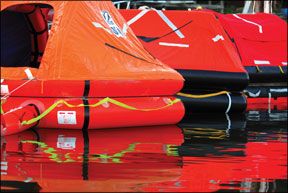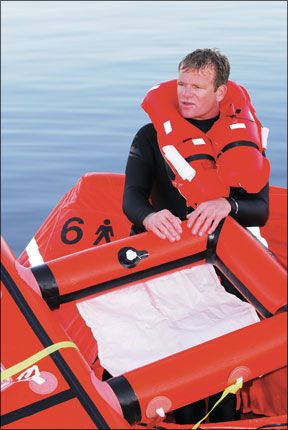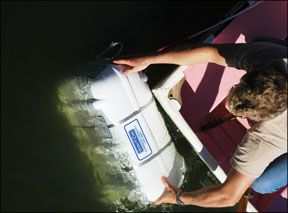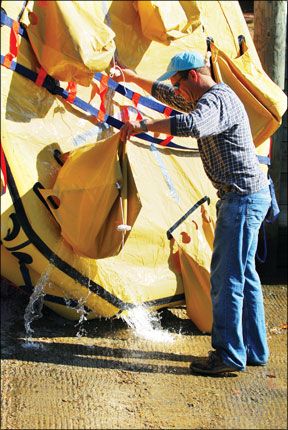Our life raft test is carried out against the backdrop of relatively new marine safety standards. New criteria for life rafts for recreational boats have been established by the International Sailing Federation (ISAF) and the International Standards Organization (IS0). The Practical Sailor comparison features an in-depth look at eight life rafts: the DSB ISAF raft, Elliot SOLAS raft, Switlik MD-3 raft, Switlik SAR-MKII raft, Viking RescYou (UKL), Viking RescYou Pro (USKL), Winslow Ocean Rescue, and the Zodiac Class Ocean ISAF raft. As far as standards go, SOLAS is clearly top notch.
***
Since our last extensive test of life rafts in 2002, both the International Standards Organization (ISO) and the International Sailing Federation (ISAF) formal guidelines for building recreational small-craft life rafts have taken shape, and the major players are scrambling for certification under these standards. Whenever an industry reviews its own standards, Practical Sailor re-examines its own testing procedures and criteria.

288
Against the backdrop of this new regulatory landscape (see “Life Raft Standards,”), we carried out an in-depth test of eight life rafts: DSB ISAF raft, Elliot SOLAS raft, Switlik MD-3 raft, Switlik SAR-MKII raft, Viking RescYou (UKL), Viking RescYou Pro (USKL), Winslow Ocean Rescue, and the Zodiac Class Ocean ISAF raft.
In our last life raft test (“Life Rafts Revisited,” Jan. 15, 2003) the Winslow Ocean Pro was our favorite, and the Viking RescYou Pro earned Best Buy honors. This time around, we were curious to see how life rafts built or upgraded to the new standards compared to the ones we tested. We also wanted to see how Elliot, a life raft we did not test last time, would do.
Next month, we’ll take an in-depth look at the results of those tests, but before delving into the details of our findings, we present here a discussion no less important of the considerations that every sailor must weigh when choosing a life raft.
There is no one life raft that will suit every person or budget. However, through our weeklong evaluation process, we were able to come up with recommendations to help clarify the differences among offshore/ocean-capable life rafts and allow you to better decide which features are most relevant to your circumstances.
Risk Check
Picking the right life raft for your own needs starts with an evaluation of the risks and the exposure you may encounter. In warm, inshore and coastal waters, hypothermia and the risk of being caught out in a heavy gale are less likely. Assistance is closer at hand. Consequently, a lighter-duty, less-expensive life raft may suit the needs of your crew. However, those cruising offshore (20 miles or more from the coast) and/or transiting colder waters, face shorter survival times. Their life rafts need to be capable of performing in more significant seas and lower temperatures.
When you abandon ship, lives are at stake. So when you’re shopping for a life raft, what may begin as a hunt for a good bargain might quickly evolve into a sky-is-the-limit search for the best life raft money can buy. Perhaps no major gear purchase elicits more hand-wringing and reflection than that of the life raft.
In some ways, our survey was like grading graduate students at a top-notch university all of the life rafts were quality products, but each had a slightly different approach to accomplishing the same objective. In some instances, little nuances were a very big deal. We found a few clear examples where one life raft maker would use relatively simple engineering and quality materials to achieve a particular result, while another would take a more complicated, expensive route with nothing gained.
Setting standards
Commercial and military interests have long known the relationship between life rafts and survival at sea, and following the Titanic tragedy, more and more agencies regulating maritime operations set standards for the structure and design of life rafts and other life-saving devices. The International Maritime Organization’s (IMO) Safety Of Life At Sea (SOLAS) Convention set standards for commercial life rafts, and these have become the benchmark by which all other life rafts are measured.
Until recently, recreational life raft design and construction in the U.S. was a self-regulated industry, one in which manufacturers independently set design criteria that might or might not have complied with the rules of the U.S. Coast Guard, SOLAS, and other life raft regulatory bodies.
The recently completed European ISO Standard 9650 defines what a recreational life raft should be capable of enduring and how it should be built. International life raft companies and some domestic builders now manufacture their products to these standards. To further complicate the issue, the ISO standards for aviation life rafts differ from the ISO marine standards, so compliance with one standard does not mean compliance with the other. Most notably, the marine standards place a higher importance on more durable material than the ISO aviation standards.
The ISAF, the governing body of international sailboat racing, is another new player in the life raft regulatory game. To compete in an ISAF-sanctioned, Category 1 or Category 2 event, a boat must have a life raft that conforms with the new ISAF standards. It’s interesting to note that ISAF mandates SOLAS rafts for Category 0 races, those held in the most extreme conditions, and, of course, accepts them for all other events. This is further endorsement of SOLAS as the gold standard of inflatable life rafts.
With prices of a good SOLAS life raft running lower than some recreational life rafts, it’s surprising that SOLAS life rafts aren’t seen aboard more sail and powerboats headed offshore. One reason that cruising boats don’t favor these life rafts is the added weight and bulk of the canisters and extra water and survival gear stowed with the life raft. As we took a closer look at this subject, we discovered some interesting facts about the weight and bulk of SOLAS life rafts, and how both might be reduced without compromising the life raft itself.
Material Perspective
Within the alphabet soup of regulatory agencies is some valuable guidance. One of the most telling statements is found in ISO 9650-1 of the “International Standard for Small Craft Inflatable life rafts.” The section states that life rafts built and maintained to the ISO Type I standards should provide “a reasonably safe refuge for a shipwrecked person awaiting rescue…(be) designed for extended voyages, where high winds and significant wave heights may be experienced, but excluding abnormal conditions such as hurricanes…not (for) voyaging in extreme zones (e.g. Southern Oceans).”
A study commissioned by the Australian government after the storm-swept Sydney-Hobart Race of 1998 further clarifies the hierarchy of life rafts in the eyes of experts. The commission recommended SOLAS-grade life rafts for future races.
But not even a SOLAS life raft comes with warranties that state “will survive in all conditions.” As one industry expert put it, “if the conditions are bad enough to cause your primary vessel to founder, how much can you expect from a 100-pound life raft?” The answer is quite a bit.
Fundamental to the integrity of any life raft is the material with which it is constructed and the quality of construction, so it is not surprising that the new ISO 9560 standard addresses material tear-test and breaking strength. These same material specs are adopted by the new ISAF standard.
288
Modern inflatable life rafts are made of tough nylon fabrics that have been coated or “calendared” with natural or synthetic rubber to make them air tight. The tear strength of the material and seams are engineered to withstand impact loads associated with breaking seas and abrasion from curious sea creatures. The trade-off between weight and rugged reliability is a tough balancing act and good engineering is essential.
We noted significant variation in the materials chosen for the hull tubes. At one extreme is the Winslow Ocean Rescue, which had a composite construction using six layers of neoprene coating along with biased-cut, rip-stop nylon, for a total weight of 8 ounces per square yard. The new Winslow ISAF life raft being introduced this year will be 10 ounces per square yard. At the other end of the spectrum is the SOLAS-approved, urethane-coated, 16-ounce-per-square-yard material used in the Elliot SOLAS life raft. Switlik also uses a heavy-duty, urethane-coated (inside and out), 16-ounce nylon for the tubes in both its life rafts we tested. Viking uses a slightly lighter denier nylon coated with natural rubber in both life rafts we tested. (Both Viking rafts meet ISO 9650 criteria.) The DSB ISAF-6 life raft was quick to enter the market with a lightweight material that meets the ISO 9650-1 tear-test and breaking strength standards. Zodiac’s PVC-coated nylon also meets the ISAF spec and is orange, adding to the life raft’s overall visibility. West Marine also has a new offshore design under development that’s slated to be available this year.

288
It’s hard to say what is tough enough. Survivors of shipwrecks who tout one brand of life raft or another are both fortunate and biased. Statistics regarding life raft failure are slim. Even more rare are accounts of why the life raft failed to help save people non-inflation, destruction by the elements, or inability to board a functioning life raft are all possibilities.
Major disasters like the 1979 Fastnet Race and the 1998 Sydney-Hobart event do shed some light on the violent impact of breaking seas. Those who review these events arrive at similar conclusions as commercial life raft experts who have defined USCG and SOLAS life raft characteristics: Sailors cruising or racing in the colder, gale-swept, higher latitudes are better off with a well-made SOLAS life raft. If you have neither the room nor the ability to handle the larger canister and heavier weight, you do have another option: a valise-packed SOLAS life raft.
The SOLAS life raft we tested, the Elliot six-man (the minimum carrying capacity for a SOLAS life raft) weighed 167 pounds, with 39 pounds worth of survival equipment and a rugged, fiberglass, drop-proof canister that alone weighed 38 pounds. The same life raft packed in a valise with a more basic survival kit would weigh about 105 pounds and still offer the rugged quality of a commercial life raft. Any survival gear that you omit could be augmented via an abandon-ship bag kept in the deck locker used to house the life raft.

288
Certainly, the life raft’s toughness is only one of several key considerations. In warm, temperate, or trade-wind conditions, a lighter life raft that is easier to launch and stow may be the best alternative. Once the life raft is inflated and the crew on board, a watermaker and a 406 EPIRB will become the crew’s next best friends.
Abandoning ship
Prior to this test, we reviewed a small-craft survival situation and scrutinized what really goes on during an abandon-ship procedure. Typically, the event is highly chaotic, inducing reactions steeped with anxiety, and at the same time, it requires a multifaceted response. The first challenge is damage control: Efforts aimed at stemming the ingress of water or fighting a fire and saving the vessel. At the same time, a mayday message must be transmitted and other SOS signals deployed. If the damage-control effort proves to be fruitless, the crew must switch into abandon-ship mode getting the raft launched, secured alongside, and crew and useful gear transferred into the life raft. The less time available for this scenario to unfold, the more demanding the process becomes, and the more essential it is to have a good life raft and a well-trained crew. (See “Abandon Ship,”)
Devilish Details
Every life raft in this test utilized a zipper to control the main opening(s). Should one or more of these zippers fail (not unlikely given the history of these fasteners in salt water), conditions could become unsafe in heavy weather or cold conditions. Some zippers were simply much more rugged that others. The waterproof YKK zipper on the Switlik MD-3 failed during its initial use, leaving a sizable opening in the canopy. (Switlik now has the raft and is looking into this.) Given our experience with zippers in general, we’d like to see all manufacturers sew in a set of simple loops or tabs along the perimeter of the zipper’s arc that could be used to lash the openings closed. A few life rafts tested did have back-up ties, although in our opinion, these were insufficient for providing a secure seal.
As it turns out, the canisters account for much of the weight of these life rafts. The packed weight of the heaviest canister life raft was nearly twice that of the lightest. However, the weight gap between the lightest and heaviest life raft, on their own, was far less. While the Elliot life raft’s hefty canister tipped the scales at 38 pounds, the lightest entrant in the test was the DSB-ISAF canister, which weighed just more than 12 pounds and was made of a higher-tech-laminate. Getting the life raft deployed is one of the toughest challenges for a shorthanded crew, and it’s sad to see how little attention naval architects give to the canister design process, which could potentially mean life or death.
Many manufacturers offer canister-mounting brackets that can be or are equipped with a hydrostatic-release mechanism. In case of a rapid sinking, when the crew fails to manually deploy the life raft in time, the life raft automatically releases.
288
With a hydrostatic release, as the life raft and vessel submerge, the change in atmospheric pressure causes the release to fire, unlatching the canister from its cradle. As the uninflated life raft floats toward the surface, residual air in the canister and life raft oppose the pull of the sinking vessel to which the life raft may be tethered, creating enough tension in the painter to inflate the raft. While this auto-inflation scenario is plausible, we found that many uninflated life rafts don’t have a whole lot of buoyancy, and it is not impossible that a life raft could be dragged down with a sinking boat for some time before inflating, if it did at all. (After our test, Switlik said it was enlarging the MD-3 canister, which would add more buoyancy.)
Vacuum-packed life rafts placed in small canisters and larger canisters with bottom drain holes and a larger hole where the painter line exits retain very little residual air. The tension between a slowly sinking vessel and an uninflated life raft would have been enough to inflate the hair trigger life rafts that we tested, those that inflated with only about 10 pounds of pull. But one of the sample life rafts in our evaluation, the DSB ISAF-6, required a 40-pound-plus pull to initiate inflation.
Float-free capability is a great idea, but the lack of positive buoyancy in an uninflated life raft, and other issues including rigging clutter, the possibility of a hydrostatic release malfunction, and simply Murphy’s Law make manual deployment the best bet.
Mounting
Life raft location is a challenging question to answer. A strong, fit person may be able to heft and heave a life raft of about 100 pounds. However, darkness or a slippery, submerged deck can significantly complicate the issue. You want to place the life raft where it will not be prematurely launched by a boarding sea and yet can be slid over the side. On a small sailboat, that location can be hard to find. All too often, the best spot is high on a coach roof, and the brackets are bolted through a deck that was never intended to carry the shear loads that a breaking wave could exert on such an installation. In a worst-case scenario, the life raft and mounting bracket rip away, leaving a hole in the cabin top. Be sure that the mounting point is structurally sound enough to handle the loads imposed by breaking seas. Some makers show their life rafts clamped to a stern pulpit, a structure not intended to take these loads.
Once the life raft is launched and inflated, it can be brought alongside a sinking vessel for the crew to transfer directly into the life raft without jumping into the sea. At this point, the larger the opening, the better. However, once everyone is in the life raft, the optimum opening size changes. If the abandon-ship situation includes fire or rapid sinking, it may become necessary to enter the water before entering the life raft, and the best method is to jump in close to where the painter can be grabbed and work your way to the life raft rather than attempting to swim to it. Clothing and a PFD can make climbing into a life raft cumbersome.
Our professional yacht captain/ex-naval officer and in-the-water evaluator, Eric Naranjo, ranked boarding aids as the most important safety feature on a life raft: “A life raft doesn’t do you any good if you can’t get in it,” he said. And the inflatable, mini-porch-like platforms found on the Elliot, Zodiac, and Winslow made for the easiest boarding.
Crew weakened by cold water and encumbered by the stress of a survival situation are often exhausted when it comes time to get into a life raft. This point was driven home during our wave pool tests in 2000 (Practical Sailor May 1, 2000 and June 1, 2000).
A good life raft not only prolongs your ability to survive, but also adds to your chance of being rescued. Despite the fact that some rafts can be trimmed up by retractable water ballast bags and actually sailed downwind at a knot or two, the real hope for rescue lies in being visible to others. In a passive sense, this may mean a ship’s crew seeing your yellow, orange, or red canopy, or a spotlight hitting the reflective tape of the canopy at night. Signaling mirrors, flares, water-surface streamers, VHF radios (marine and aviation), EPIRB, SART cell, and sat phones all play a role in being visible.
Next month, we’ll do our raft-by-raft evaluation. Following that, we’ll compare the various survival kits and examine what belongs in an abandon-ship bag.







































